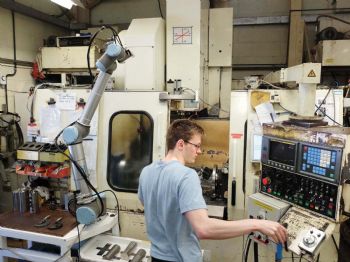
Predominantly a sub-contract machinist of turned parts that require a significant amount of milling and drilling, Rousant Sherwood Manufacturing — based in Henley-on-Thames — uses more than a dozen CNC lathes, mainly from the Japanese manufacturer Nakamura.
However, for expediency, some parts are mill-turned on vertical-spindle machining centres (VMCs); these include a line of three Topper machines built in Taiwan, one of which was automated last year.
The economic benefits of this automation are such that the machine now works mostly autonomously, allowing one operator rather than two to attend all three Toppers — halving the labour cost involved in producing a range
of stainless-steel load cells for a manufacturer of weighing equipment.
Different types of load cell are produced with the other two Topper VMCs, and there are plans to automate these
as well.
As with many automation initiatives in the factory, adapting the VMC was instigated by Ray Haywood, who owns the sub-contracting firm.
He says this automation is a prime example of how a three-axis machining centre that was formerly loaded and unloaded manually (in this case, for Ops 1 and 2) can be configured for automation at a reasonable cost.
The conversion was carried out by Andy Packman from Projex Design, which is on the same industrial estate at Henley-on-Thames.
‘Automated gripping’
A range of hydraulic work-holding equipment from Hitchin-based Roemheld UK (
www.roemheld.co.uk) was chosen for the project.

It included: an MC100Z concentric vice and a block cylinder that acts as a tailstock to secure the component between centres for Op1; a pair of swing clamps to hold the component for Op2; rotary unions for both pre-existing pneumatically operated indexing heads to feed the hydraulic power to the fixtures without tangling the hoses; and a hydraulic power pack (its actuation is sequenced by signals from the robot controller, which has been programmed
to manage component handling).
As is often the case with Mr Haywood’s equipment purchases, he ‘surfed the Internet’ to research a hydraulic work-holding solution, initially for Op2, and then approached a number of potential suppliers.
He said the response from Roemheld UK was both prompt and efficient; and because the hydraulic swing clamps were also of high quality, the order was placed.
The original plan was to use a two-jaw chuck to hold the component for Op 1, but Roemheld suggested a solution based on a hydraulic vice and tailstock (which was also bought).
With the help of Projex Design, the cell was configured so that, as well as loading, transferring and unloading workpieces, the robot automatically opens and closes both VMC doors (which were modified as necessary), making the manufacturing process fully automatic.
At the start of a day’s production, the robot opens the VMC’s doors, picks up a 67mm-diameter x 180mm-long cylindrical stainless-steel billet (weighing 8kg) from a table at the front of the machine and places it in a horizontal orientation in the hydraulic Roemheld vice.
The tailstock advances so that its centre pushes the billet to an end stop at the back of the jaw, then full clamping pressure is applied.
‘Flat milling’
With the billet held securely in position (and free to be rotated through 360deg by the left-hand indexing head on which the vice is mounted), Op1 consists of milling two diametrically opposed flats along its length, drilling and chamfering three holes through the flats — and drilling and grooving two blind holes on either side, so that the web thickness is to within ±0.05mm (this is the tightest drawing tolerance; to achieve it, the depth of each blind hole must be controlled to 0.025mm).
The component is then indexed through 90deg for a small pocket to be milled.
After opening the doors, the robot picks up the part-machined component and transfers it to the Op2 fixture, mounted on the second indexing head on the right-hand side of the VMC table, where the workpiece is secured by the Roemheld swing clamps.

A fresh billet is loaded into the vice, so that its Op1 cycle can be completed simultaneously with Op2 on the first part, while the doors are closed.
Op2 comprises drilling and tapping a blind hole in one end face of the billet and drilling two holes at an angle through the small pocket on the side, so that they intersect internally. The entire cycle takes just over 1hr to complete.
When the robot opens the doors again and the hydraulic pressure is released, the finished part is moved from the Op 2 fixture to the component tray, the part-machined Op 1 workpiece is transferred to the Op 2 position, and a new billet is loaded into the Op 1 fixture.
The doors are then closed and the cycle starts again.
The process continues with minimal operator intervention throughout the day, although it is possible to run the process manually — for instance, to prove out an alteration to the machining sequence.